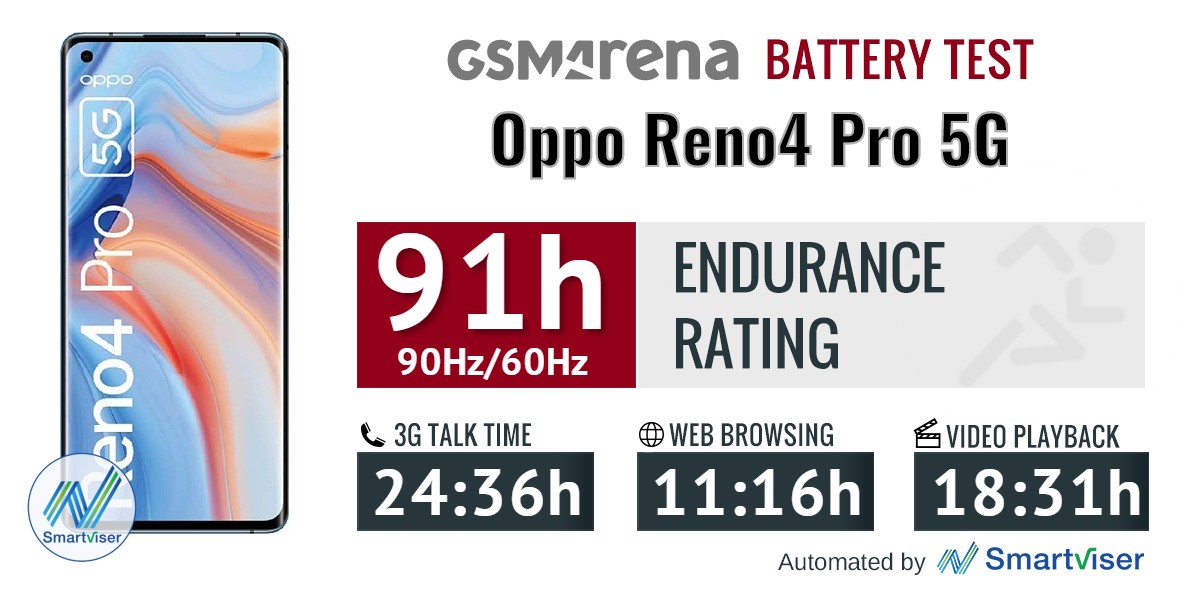Introduction
Headlining the Reno4 family, the Oppo Reno4 Pro 5G comes with a capable Snapdragon 765G chipset, a 90Hz AMOLED display, and a tri-set of cameras on its back. We reviewed the 4G-only version a while ago, and it's now time for the 5G variant.
 Reno4 Pro 5G (left) next to Reno4 Pro
Reno4 Pro 5G (left) next to Reno4 Pro
It's not just the next-gen connectivity that sets them apart, mind you. As part of the upgraded chipset, you'd also be getting a boost in performance over the Reno4 Pro, particularly in the graphics department. In a way, it's a flagship-grade chip - if the Pixel 5 can pass for a flagship.
Additionally, the 5G version's camera system is a marked upgrade over the plain Reno4 Pro's setup, even though it's one unit short and it's using the same primary shooter. Here, you're getting a 2x telephoto, which is missing on the other phone, and a nicer 13MP ultra-wide replaces the 8MP unit and doubles as a macro cam thanks to its autofocusing capability.

A few other differences can be spotted elsewhere, and it's mostly a matter of things that are missing - there's no microSD slot or headphone jack on this model, and an FM radio is nowhere to be found either. On a positive note, the 5G version comes with stereo speakers, and that's twice as many as on the 4G variant.
Oppo Reno4 Pro 5G specs
- Body: 159.6x72.5x7.6mm, 172g; Glass front (Gorilla Glass 5), glass back (Gorilla Glass 5), aluminum frame; Colors: Galactic Blue, Space Black, White, Pink, Green.
- Display: 6.55" AMOLED, 1080x2400px resolution, 20:9 aspect ratio, 402ppi; 90Hz refresh rate.
- Chipset: Qualcomm SDM765 Snapdragon 765G (7 nm): Octa-core (1x2.4 GHz Kryo 475 Prime & 1x2.2 GHz Kryo 475 Gold & 6x1.8 GHz Kryo 475 Silver); Adreno 620.
- Memory: 128GB 8GB RAM, 256GB 12GB RAM; UFS 2.1.
- OS/Software: Android 10, ColorOS 7.2.
- Rear camera: Wide (main): 48 MP, f/1.7, 26mm, 1/2.0", 0.8µm, PDAF, Laser AF, OIS; Telephoto: 13 MP, f/2.4, 52mm, 1/3.4", 1.0µm, PDAF, 2x optical zoom; Ultra wide angle: 12 MP, f/2.2, 120˚, 1/2.43", 1.4µm, AF; LED flash, HDR, panorama.
- Front camera: 32 MP, f/2.4, 26mm (wide), 1/2.8", 0.8µm; HDR.
- Video capture: Rear camera: 4K@30fps, 1080p@30/60/120fps; gyro-EIS, OIS, HDR; Front camera: 1080p@30fps, gyro-EIS.
- Battery: 4000mAh; Fast charging 65W, 60% in 15 min, 100% in 36 min (advertised), SuperVOOC 2.0.
- Misc: Fingerprint (under display, optical), accelerometer, gyro, proximity, compass; NFC.
Oppo Reno4 Pro 5G unboxing
The Reno4 Pro 5G arrives in much the same package that we got the non-5G version. A teal sleeve with a dreamy soft Reno device holds the white cardboard box.

A full set of accessories can be found inside. The 65W SuperVOOC 2.0 charger is the most essential bit, and there's a cable to go with it - as usual with proprietary charging systems, you better hold on to both the adapter and the cable if you want the 30-something minute charging capability.
A set of earphones is included too, and they look pretty neat - the Oppo-green meshes against the white of the buds serve as a nice accent. A clear silicone protective case for the handset completes the bundle.
Design
The Reno4 Pro 5G falls in a particular upmarket niche of the midrange, and it's got the look and feel to show for it. A dual-glass sandwich held together by an aluminum midframe is the go-to design for a premium handset, and the Reno takes that approach, too.

Best as we can tell, the Reno4 Pro 5G uses Gorilla Glass 5 front and back - that's according to Corning for the physically identical Chinese variant of the phone. The back isn't glossy - instead, it has a fine frosted finish with a gentle sheen to it.

Our review unit is in the Galactic Blue colorway, and that's a two-tone double gradient between different shades of blue. Global markets also get Green Glitter with a similar finish to our blue one, and a glossy Space Black with a pattern of Os and Ps scattered about (you know, for OPPO). China, meanwhile, also gets a pink gradient and a white-only variant.

We can speak of the blue one we have here, and that experience likely extends to the green one, but it's really slippery. Glossy panels tend to provide some grip against fingertips; this one doesn't. On a positive note, it doesn't pick up fingerprints nearly as much as a glossy back would, and that's no small advantage.

The camera cluster has three modules stacked vertically, each with its own oversized glass element surrounded by a metal ring. The cameras stick out a bit from an already slightly protruding camera bump that also houses the flash and the laser focusing bits. The assembly is offset to the side and raised enough to make the phone prone to wobbling on a flat surface if you tap on it.

On the front, you're greeted by the 6.55" AMOLED display with curved side edges and relatively thin bezels. The curved edges are a signature premium touch, and on the Reno4 Pro 5G, they're very gentle, making for a negligible color shift and posing no issues for usability.

The selfie camera is in a punch-hole cutout in the top left corner. The curves get somewhat in the way of placing the module at the very corner, so it's been nudged a bit inwards wasting some screen area, though we reckon that hardly bothers anyone at this point.
The earpiece is behind a grille etched equal parts into the frame and the display glass. It also doubles as a loudspeaker in a stereo pair.

The physical controls on the Reno are in a classic setup that you rarely see anymore - the power button is on the right, the volume buttons (two separate ones as opposed to a rocker) are on the left.


Power button on the right • Volume controls on the left
The flat bottom is home to a USB-C port, the main loudspeaker, primary mic, and SIM card tray. It's a SIM-only tray, sadly - no microSD slot on this one.
Up on the top, there's another mic for the noise-cancelling in phone calls and stereo audio recording in video capture.


The Reno takes two nano SIMs back to back • Secondary mic up top
The Reno4 Pro 5G measures 159.6x72.5x7.6mm and weighs 172g. It feels very nicely slim in hand with the already minimal 7.6mm melting away towards the curved sides front and back. It's also almost surprisingly lightweight - 172g is not a lot in today's smartphone space, and the Reno is, indeed, less of a burden on your pocket than most.

Excellent 6.55-inch AMOLED display
The Reno4 Pro 5G is equipped with a 6.55-inch AMOLED display with a 1080x2400px resolution in a 20:9 ratio. For whatever reason, Oppo lists the diagonal at 0.05 inches more than the non-5G Reno4 Pro, but it may very well be the same panel. It supports a 90Hz refresh rate, while the touch sampling goes all the way up to 180Hz.

Much like the 4G version, the Reno4 Pro 5G claims a max brightness of 500nits in regular use, up to 800nits in bright ambient light, and a peak of 1100nits. That last number is for HDR applications, while the other two are for full-screen illumination. OLED displays can go brighter when they don't have to power up the entire screen area. We always test at 75% average picture level, so this explains the difference between advertised numbers and the numbers we get.
We measured similar brightness on the Reno4 Pro 5G as we did on the 4G, as well as on the Reno3 Pro 5G. That's both with manual slider adjustment and in auto-brightness under direct light - 515nits and 845nits, respectively. Both are great results and in line with what you can get on top-tier handsets (save for the Note20 Ultra that can push beyond 1000nits in our testing setup).
| Display test | 100% brightness | ||
| Black, |
White, |
||
| 0 | 515 | ∞ | |
| 0 | 845 | ∞ | |
| 0 | 508 | ∞ | |
| 0 | 843 | ∞ | |
| 0 | 510 | ∞ | |
| 0 | 819 | ∞ | |
| 0 | 410 | ∞ | |
| 0 | 642 | ∞ | |
| 0 | 416 | ∞ | |
| 0 | 595 | ∞ | |
| 0 | 475 | ∞ | |
| 0 | 699 | ∞ | |
| 0 | 405 | ∞ | |
| 0 | 617 | ∞ | |
| 0 | 323 | ∞ | |
| 0 | 756 | ∞ | |
| 0 | 496 | ∞ | |
| 0 | 803 | ∞ | |
| 0 | 379 | ∞ | |
| 0 | 797 | ∞ | |
| 0 | 404 | ∞ | |
| 0 | 823 | ∞ | |
The Reno4 Pro has two color presets - Vivid (the default one) and Gentle. There's an additional Cool-to-Warm slider offering stepless adjustments in either mode. In our testing, Vivid mode returned an average dE2000 of 3.9 for the standard set of DCI-P3 test swatches with excellent sub-2 results on the primaries, but way off in terms of white and grayscale rendition - purplish whites some 10 units off the mark. Move the slider all the way to the Warm right, and you'd get an average dE2000 of 2.9 and somewhat better whites and grays (dE2000 ~7, now pinkish).
Gentle mode is where you'd go for sRGB-tuned colors, though things aren't too peachy to start with. Again, we measured excellent results on the RGB CMY, but a poor white point rendition (dE2000 ~10, blue) and an average dE2000 of 3.8. Again, we got a better overall rendition with the temperature slider at the Warmest setting (2.9 average, white around 6). Overall, reasonably accurate colors from the Reno4 Pro 5G, nearly the same as on the 4G, but a noticeable blue/purple shift in the default state and no real option to fix that.
Much like on the Reno4 Pro non-5G, the HDR capability of this one isn't a straightforward topic. Oppo doesn't mention HDR in the promo materials, but the phone clearly supports some sort of HDR.
YouTube serves the Reno HDR versions of compatible videos, and you can clearly see the phone shift its colors and brightness. Amazon Prime, too, shows HDR icons next to supported titles. On the other hand, Netflix doesn't want to play nicely, and while it does deliver 1080p resolution, it refuses to do so in HDR. This could be a temporary state, and a fix could technically be in the making. However, if our experience with the 4G version of the phone is any indication, such a development seems unlikely.

High refresh rate handling is also done in a way we're familiar with from the 4G model. With the phone set to 90Hz, you'll get 90Hz across the UI and in browsers too. However, it will switch to 60Hz for anything related to video playback - the native player and Netflix once you play something, YouTube (as soon as you open the app). That's the same behavior you'll get if you opt for the 'Auto Select' option in the display refresh rate settings menu.
The 60Hz option locks the display at 60Hz, simple as that.
Oppo Reno4 Pro 5G battery life
The Oppo Reno4 Pro 5G packs a 4,000mAh battery, which is relatively standard for the class. It's the same capacity as what the non-5G version gets and a nominal downgrade from the odd 4,025mAh of the Reno3 Pro 5G.
Despite all the similarities in hardware between the 3 and 4 generations of Reno Pro 5Gs, the battery results turned out different in our testing. The Reno4 Pro 5G posted an 18:31h result in video playback, up from 16:11h on the older phone. In web browsing, however, we clocked a lower result - 11:16h on the 4 vs. 14:13 on the 3.
A little clarification is due here - the video playback test was carried out at 60Hz only since the phone will switch to that refresh rate when it detects a video is playing, regardless of what mode the display is set to. As for web browsing, the 11:16h result is measured with the screen at 90Hz (going for 60Hz got us precisely one extra hour to 12:16h).
The Reno4 Pro 5G is good for a full day of constant voice calls if you're up for it.
The individual results add up to an Endurance rating of 91h - a small downgrade from the Reno3 Pro 5G's nice and round 100h.

Our battery tests were automated thanks to SmartViser, using its viSer App. The endurance rating above denotes how long a single battery charge will last you if you use the Oppo Reno4 Pro 5G for an hour each of telephony, web browsing, and video playback daily. We've established this usage pattern so that our battery results are comparable across devices in the most common day-to-day tasks. The battery testing procedure is described in detail in case you're interested in the nitty-gritty. You can check out our complete battery test table, where you can see how all of the smartphones we've tested will compare under your own typical use.
Battery charging
The Reno4 Pro 5G comes with a 65-watt SuperVOOC 2.0 charging adapter inside the box. The system provides spectacular charging speeds.
In our testing, the Reno4 Pro 5G battery took 32 minutes to go from flat to full. The battery indicator showed 97% at the 30-minute mark (our standard testing duration). SuperVOOC is a true chart-topper when it comes to charging speeds.
30min charging test (from 0%)
- Oppo Reno4 Pro
98% - Oppo Reno4 Pro 5G
97% - OnePlus 8
69% - Oppo Reno3 Pro
67% - Samsung Galaxy S20+
62% - OnePlus Nord
60% - vivo X50 Pro+
60% - Galaxy S20 FE (25W)
57% - Google Pixel 5
41% - Motorola Edge
37% - Galaxy S20 FE (15W bundled)
37% - LG Velvet
36%
Time to full charge (from 0%)
- Oppo Reno4 Pro
0:31h - Oppo Reno4 Pro 5G
0:32h - OnePlus 8
0:53h - Samsung Galaxy S20+
0:57h - OnePlus Nord
1:05h - Galaxy S20 FE (25W)
1:10h - vivo X50 Pro+
1:11h - Oppo Reno3 Pro
1:12h - Galaxy S20 FE (15W bundled)
1:35h - LG Velvet
1:52h - Google Pixel 5
1:54h - Motorola Edge
2:32h
Speaker test
The Reno4 Pro 5G comes with a stereo speaker configuration - that's the Reno3 Pro 5G's setup, as opposed to the mono-only non-5G Reno4 Pro. It ranks in the 'Very good' category for loudness in our 7-track music test - same as the previous generation, notably better than the 4G model of the current one.

We found it somewhat lacking in the lower frequency region, but that aside, it's a very well sounding phone for video watching and music playback alike.
Use the Playback controls to listen to the phone sample recordings (best use headphones). We measure the average loudness of the speakers in LUFS. A lower absolute value means a louder sound. A look at the frequency response chart will tell you how far off the ideal "0db" flat line is the reproduction of the bass, treble, and mid frequencies. You can add more phones to compare how they differ. The scores and ratings are not comparable with our older loudspeaker test. Learn more about how we test here.
Audio output quality
We've recently discontinued our audio output quality test.
The reason for that is that most phones that arrived for testing were already excellent in this regard. Whatever difference there was, it was marginal and probably indistinguishable by anything but our lab equipment.
ColorOS is at 7.2 on the Reno4 Pro 5G
The Reno4 Pro 5G runs ColorOS 7.2 - the same version most recent Oppos get. The custom overlay is on top of Android 10. Perhaps Android 11 will arrive at some point.

The homescreen situation is predictable - you get to choose between the simplified approach with all the apps arranged on the homescreens (the out of the box state) or the two-tiered homescreen + app drawer way. The UI basics are entirely ordinary.






Lockscreen • Homescreen • Folder view • App Drawer • Quick toggles and notifications • Task switcher
The app icons themselves are super customizable. You can set up a custom shape, adjust the corner rounding. We found no theme store on this unit, and there was just a single theme pre-installed.






Homescreen settings • Homescreen settings • Homescreen mode • Swipe down options • A theme • Icon settings
Navigation options are aplenty too. We've already grown used to and prefer the standard Android 10 navigation (Swipe Gestures from Both Sides, it's called here), which employs the side edges for going Back while upward swipes from the bottom take you Home.
Color OS has a gesture for a quick switch between the last two apps if you swipe in for Back, but hold for a brief instant. That's optional, and it can work in addition to the default side swiping on the bottom of the screen.
A classic three-button navigation bar is available if you're old school like that, and it lets you choose between two layouts. There's also a More option, which will take you to the Swipe-up gestures alternative - the middle option between the navbar and real gestures.
The Smart Sidebar feature we've seen on other ColorOS builds is here too. A swipe in from the side opens a toolbar with actions and shortcuts. You can customize them and also adjust the bar's position and opacity.






Navigation options • Smart sidebar
The Reno4 Pro 5G display supports a 90Hz refresh rate, and you get a three-way setting between 90Hz, 60Hz, and Auto. As we detailed on the previous page, that setting is only ever set in stone if you have it at the 60Hz position, with the other two modes adjusting it to optimize the experience.
There's a system-wide dark mode, and it can be engaged permanently or according to a schedule. It'll invoke supported apps' dark themes too, but you can also enforce dark mode on third-party apps which don't have it built-in.
Always-on Display is available too, and that's the menu item for it, as opposed to the "Screen-Off Clock" name on previous builds. It gives you a choice between different clock styles and can be set to be on all the time or according to a schedule (but not follow sunset and sunrise patterns). Edge lighting (formerly Screen Light Effect) is like the edge notification lighting on Samsung phones minus the high customizability.
Picking up the phone lights up the fingerprint reader area for a short while. However, you can't bring it up with a tap when the phone is lying flat on the table. You will have to gently push the phone because we noticed that the FP area is triggered by the accelerometer. A double-tap-to-wake is always an option, but this will light up the whole screen.

The overall fingerprint reader experience is hard to fault. Recognition is super-fast, accurate, and responsive. Also, the area is big enough, so you don't have to be that precise when placing your finger on top.
Basic face recognition is available too. It uses just the selfie cam (so no fancy 3D scanning) and isn't as secure as the fingerprint reader, but it's fast and convenient. The phone can be set to require at least one open eye for added security.





Fingerprint, Face & Password settings
Drawing letters on a turned-off screen is still a feature with ColorOS 7.2, and you can launch a bunch of apps with the available letters. As usual, the torch and the camera app are probably the most useful assignments. The camera app can now be set to launch with a double press on either of the volume buttons, though, which seems a lot more useful.
The multimedia apps such as Gallery, Music, and Videos are provided by Oppo. There's a File Manager, a Phone Manager, and a few other tools pre-installed, including a custom calculator and a voice recorder. As has been the trend with recent handsets by the company, the replacement of the in-house Phone and Messages apps for Google's own has made its way to the Oppo Reno4 Pro 5G too.






Gallery • Videos • File Manager • Phone Manager • Calculator • Voice recorder
Synthetic benchmarks
The Reno4 Pro 5G has the Snapdragon 765G chipset inside, Qualcomm's go-to SoC for 5G-capable midrangers. Its CPU is in a 1+1+6 configuration with a Kryo 475 Prime core that goes as high as 2.4GHz, a Gold one capped at 2.2GHz, and 6 Silver ones clocked up to 1.8GHz. Two RAM/storage options are available, and we have the fully tricked out 12GB/256GB version, but the 8GB/128GB variant is hardly underequipped either.

One of the Reno4 Pro 5G's issues is that it's priced so high, particularly in Europe, that there are competitors with good high-end chipsets that go for the same or even less money. We'll be including a few of those in the performance comparisons - the likes of the OnePlus 8, Galaxy S20 FE, and even the S20+.
In GeekBench, the Reno posts similar scores in the single-core test as others with the Snapdragon 765G but punches a little below its weight in multi-core. Top-tier devices are up to 50% more powerful under single-core loads, a difference that stretches to 80% in multi-core.
GeekBench 5 (multi-core)
Higher is better
- OnePlus 8
3399 - Xiaomi Mi 10T Pro
3311 - Samsung Galaxy S20 FE
3296 - Galaxy S20+ (120Hz, 1080p)
2703 - OnePlus Nord
1953 - vivo X50 Pro
1937 - Xiaomi Mi 10 Lite 5G
1927 - LG Velvet 5G
1905 - Motorola Moto G 5G Plus
1898 - Galaxy A51 5G
1867 - Motorola Edge
1862 - Oppo Reno3 Pro 5G
1815 - Oppo Reno4 Pro 5G
1805 - Oppo Reno4 Pro
1781 - Google Pixel 5
1647
GeekBench 5 (single-core)
Higher is better
- OnePlus 8
919 - Samsung Galaxy S20 FE
906 - Xiaomi Mi 10T Pro
901 - Galaxy S20+ (120Hz, 1080p)
886 - Galaxy A51 5G
677 - vivo X50 Pro
636 - Xiaomi Mi 10 Lite 5G
616 - Oppo Reno4 Pro 5G
615 - OnePlus Nord
610 - Oppo Reno3 Pro 5G
609 - Google Pixel 5
594 - Motorola Moto G 5G Plus
589 - Motorola Edge
586 - LG Velvet 5G
586 - Oppo Reno4 Pro
569
In Antutu, the Reno4 Pro 5G runs towards the top of the S765G bunch. Once again, it's easily outclassed by Snapdragon 865 handsets in its price range.
AnTuTu 8
Higher is better
- OnePlus 8
564708 - Xiaomi Mi 10T Pro
563961 - Samsung Galaxy S20 FE
543986 - Galaxy S20+ (120Hz, 1080p)
500114 - Galaxy S20+ (60Hz, 1440p)
489371 - vivo X50 Pro
323736 - Xiaomi Mi 10 Lite 5G
318117 - Oppo Reno4 Pro 5G
317139 - Galaxy A51 5G
316007 - OnePlus Nord
312794 - Oppo Reno3 Pro 5G
308231 - Motorola Edge
305989 - Motorola Moto G 5G Plus
299926 - LG Velvet 5G
297372 - Google Pixel 5
289261 - Oppo Reno4 Pro
261359
Even more striking are the differences in GPU benchmarks, where the high-end chipsets post results around 2.5 times higher than what the Reno4 Pro 5G can put out. Among the S765G rivals, the differences are pretty slim, and the Reno is about on par with other similarly equipped models.
GFX Manhattan ES 3.1 (offscreen 1080p)
Higher is better
- Samsung Galaxy S20 FE
89 - OnePlus 8
88 - Xiaomi Mi 10T Pro
87 - Galaxy S20+ (120Hz, 1080p)
85 - Galaxy S20+ (60Hz, 1440p)
85 - Oppo Reno3 Pro 5G
38 - Xiaomi Mi 10 Lite 5G
38 - OnePlus Nord
38 - Oppo Reno4 Pro 5G
37 - vivo X50 Pro
36 - Motorola Edge
34 - LG Velvet 5G
33 - Motorola Moto G 5G Plus
33 - Galaxy A51 5G
32 - Oppo Reno4 Pro
31 - Google Pixel 5
22
GFX Manhattan ES 3.1 (onscreen)
Higher is better
- Xiaomi Mi 10T Pro
77 - Samsung Galaxy S20 FE
77 - Galaxy S20+ (120Hz, 1080p)
75 - Galaxy S20+ (60Hz, 1440p)
43 - OnePlus Nord
34 - Motorola Edge
32 - Oppo Reno3 Pro 5G
32 - Xiaomi Mi 10 Lite 5G
32 - vivo X50 Pro
31 - Oppo Reno4 Pro 5G
31 - LG Velvet 5G
29 - Motorola Moto G 5G Plus
29 - Galaxy A51 5G
28 - Oppo Reno4 Pro
26 - Google Pixel 5
22
GFX Car Chase ES 3.1 (offscreen 1080p)
Higher is better
- Samsung Galaxy S20 FE
52 - OnePlus 8
52 - Xiaomi Mi 10T Pro
51 - Galaxy S20+ (60Hz, 1440p)
51 - Galaxy S20+ (120Hz, 1080p)
50 - Oppo Reno3 Pro 5G
21 - Xiaomi Mi 10 Lite 5G
21 - OnePlus Nord
21 - Oppo Reno4 Pro 5G
21 - vivo X50 Pro
20 - Galaxy A51 5G
20 - Motorola Edge
19 - LG Velvet 5G
19 - Motorola Moto G 5G Plus
19 - Oppo Reno4 Pro
18 - Google Pixel 5
13
GFX Car Chase ES 3.1 (onscreen)
Higher is better
- Xiaomi Mi 10T Pro
46 - OnePlus 8
46 - Samsung Galaxy S20 FE
45 - Galaxy S20+ (120Hz, 1080p)
42 - Galaxy S20+ (60Hz, 1440p)
25 - OnePlus Nord
19 - Motorola Edge
18 - Oppo Reno3 Pro 5G
18 - Oppo Reno4 Pro 5G
18 - Xiaomi Mi 10 Lite 5G
17 - vivo X50 Pro
17 - Galaxy A51 5G
17 - LG Velvet 5G
16 - Motorola Moto G 5G Plus
16 - Oppo Reno4 Pro
15 - Google Pixel 5
12
GFX Aztek Vulkan High (onscreen)
Higher is better
- Samsung Galaxy S20 FE
30 - OnePlus 8
30 - Xiaomi Mi 10T Pro
29 - Galaxy S20+ (120Hz, 1080p)
26 - Oppo Reno3 Pro 5G
19 - Galaxy S20+ (60Hz, 1440p)
14 - OnePlus Nord
13 - Motorola Edge
12 - Xiaomi Mi 10 Lite 5G
12 - Oppo Reno4 Pro 5G
12 - LG Velvet 5G
11 - Motorola Moto G 5G Plus
11 - Oppo Reno4 Pro
10 - Galaxy A51 5G
9.9 - Google Pixel 5
7.9
GFX Aztek ES 3.1 High (onscreen)
Higher is better
- Galaxy S20+ (120Hz, 1080p)
32 - OnePlus 8
31 - Xiaomi Mi 10T Pro
30 - Samsung Galaxy S20 FE
30 - Galaxy S20+ (60Hz, 1440p)
19 - Motorola Moto G 5G Plus
18 - OnePlus Nord
13 - Motorola Edge
12 - Oppo Reno3 Pro 5G
12 - Xiaomi Mi 10 Lite 5G
12 - Oppo Reno4 Pro 5G
12 - Galaxy A51 5G
12 - LG Velvet 5G
11 - Oppo Reno4 Pro
10 - Google Pixel 5
9.1
3DMark SSE ES 3.1 (offscreen 1440p)
Higher is better
- OnePlus 8
7290 - Samsung Galaxy S20 FE
7215 - Xiaomi Mi 10T Pro
7101 - Galaxy S20+ (120Hz, 1080p)
6819 - Galaxy S20+ (60Hz, 1440p)
6735 - Xiaomi Mi 10 Lite 5G
3294 - Oppo Reno4 Pro 5G
3288 - OnePlus Nord
3285 - Oppo Reno3 Pro 5G
3214 - vivo X50 Pro
3214 - Motorola Moto G 5G Plus
3031 - Motorola Edge
3004 - LG Velvet 5G
2987 - Galaxy A51 5G
2837 - Oppo Reno4 Pro
2512 - Google Pixel 5
2318
3DMark SSE Vulkan 1.0 (offscreen 1440p)
Higher is better
- OnePlus 8
6720 - Samsung Galaxy S20 FE
6605 - Xiaomi Mi 10T Pro
6412 - Galaxy S20+ (120Hz, 1080p)
6354 - Galaxy S20+ (60Hz, 1440p)
6311 - Xiaomi Mi 10 Lite 5G
3080 - OnePlus Nord
3067 - Oppo Reno4 Pro 5G
3062 - Oppo Reno3 Pro 5G
2995 - vivo X50 Pro
2983 - Motorola Moto G 5G Plus
2821 - Motorola Edge
2801 - Galaxy A51 5G
2778 - LG Velvet 5G
2758 - Oppo Reno4 Pro
2377 - Google Pixel 5
2267
The Reno4 Pro 5G delivers the numbers expected from its chipset in our set of benchmarks. It's one of the most powerful mid-range chipsets, and that's good, but with this Reno's ambitious pricing, you can have a proper current flagship chipset that will be vastly more powerful.
Proper triple camera
Much like the last generation, the Reno4 Pro 5G comes with a very different camera setup than the 4G version. This one has a real three focal length configuration next to the non-5G's 2+2 setup where two of the modules were 2MP - one each for close-ups and depth detection.

The primary cam uses the super popular 48MP 1/2" Quad Bayer sensor with a 26mm equivalent lens with an f/1.7 aperture. Unlike on the 4G version, the lens is stabilized like on the Reno3 5G. What neither of these has is laser autofocus, a new addition on the Reno4 Pro 5G.
The ultra-wide brings yet more improvements. It's a 13MP unit instead of the 8MP ones on the other two phones, and it uses a Sony IMX708 sensor that's 1/2.43" big and has 1.4µm pixels. Best of all, it has autofocusing capability and can focus very close, rendering a dedicated 'macro' cam entirely useless.
There's a telephoto too, with a 2x zoom lens at around 52mm equivalent focal length. A 13MP 1/3.4" sensor with 1.0µm pixels captures the images. This one appears lifted straight off the Reno3 Pro 5G and is a crucial advantage over the tele-less Reno4 Pro.
For selfies, the Reno4 Pro 5G is equipped with a 32MP Quad Bayer module with an f/2.4 aperture lens.

The camera app is the same one you'd find across all Oppos and Realmes. Most of the modes are on the main rolodex with side swipes in the viewfinder switching between them, one at a time. You can slide on the mode 'dial' to flip through multiple modes at a time too. Modes deemed less important can be found in an additional 'More' pane at the far right. A Dazzle Color toggle in the middle of the icon array in the viewfinder engages a color boost, a rather excessive one, we might add.
There's an Expert mode where you get to tweak exposure (ISO in the 100-64000 range and shutter speed in the 1/8000s-32s range), white balance (by light temperature, but no presets), manual focus (in arbitrary 0 to 1 units with 0 being a close focus and 1 being infinity) and exposure compensation (-2EV to +2EV in 1/6EV increments). These expert controls are only available for all three cams, which are switched from the tree icon on the viewfinder's far end.
Image quality
Daylight photos out of the Reno4 Pro 5G's main cam have a very appealing, user-friendly look. That's to say they have punchy colors (overly saturated, some will say) and a nicely wide dynamic range.
Zooming to 1:1 magnification, we see good detail levels, and it's rendered in natural way - without excessive sharpening. A bit anachronistic is the amount of grain in these images - we're used to noise-free daylight photos these days. It's not a dealbreaker by any stretch, but if noise bugs you, so will the Reno's main cam photos.
We did say that color saturation is a bit much in regular photo mode, but you can bump it further by engaging Dazzle Color mode. That'll get you livelier greens and deeper blue skies in scenes where the phone finds one of these to dominate, yet it wasn't as trigger happy in the yellow-orange fall scene in the final sample. In any case, we see no real reason to shoot with the Dazzle Color toggle engaged.






Camera samples, main camera, Dazzle Color on
We wouldn't say that shooting in 48MP on this particular phone will bring any practical benefits. We're not seeing more detail in these images, while noise is made even more prominent with the freckles now 4 times as big.






Camera samples, main camera, 48MP
The telephoto camera on the Reno4 Pro 5G does not disappoint in good light. While yes, the images are again quite noisy, they are also very sharp and detailed. Colors and dynamic range are a nice match for the main cam's performance too.









Camera samples, tele camera, 2x zoom
There's also a 5x position in the zoom selector. Its output is not spectacular at the pixel level, but you couldn't tell in fit to screen consumption.



Camera samples, tele camera, 5x zoom
The Reno4 Pro 5G's ultra-wide uses a 16:9 aspect sensor, but we shot its stills in 4:3. We'll say that we did that so that the images are comparable to the majority of rivals that shoot in 4:3. Another explanation is that we overlooked the ratio bit when shooting the samples, and by the time we realized that it was too late to redo them.
That minor mishap aside, the Reno4 Pro 5G's ultra-wide camera images are very good. Dynamic range is excellent, and colors continue along the saturated path outlined by the main cam. Sharpness and detail fall a little short of the main cam's output, but as ultra wides do, this is easily among the better ones.









Camera samples, ultra wide angle camera
The Reno4 Pro 5G's main camera generally handled our low-light test scenes well. We'd have appreciated brighter exposures most of the time, but even as it is, the photos are sharp and detailed where there's at least some light to illuminate the scene. Noise is also present, but since it was already there in broad daylight, we expected nothing else from the night scenes, and it's really a non-issue under the circumstances.
Dynamic range is fairly wide too, and note that the yellow postal service building in the first samples was unusually challenging due to some of the floodlights being out of order. The point being, the Reno did well. Colors remain accurate unless there are warm light sources in the frame, which often result in a strong orange cast, and this phone is a particularly bad offender in this respect.






Low-light samples, main camera, Photo mode
That gets further intensified in Night mode, making for a very orange rendition of these warmly-lit subjects. However, it does bring benefits in shadow development where you now get entire previously unseen portions of the image lifted out of the dark. Highlights, too, get toned down, though the recovered areas are susceptible to the orange cast. Additionally, some slight detail loss is also observed through a common trade-off in Night modes as the phones align and process the multiple exposures. The flipside is the reduced noise when shooting in Night mode.






Low-light samples, main camera, Night mode
The ultra-wide cam is struggling for light in the dark and will turn in soft and mushy shadows. Zoom out to fit to screen level, and the images look okay with decent if not impressive dynamic range and better handling of warm light sources.






Low-light samples, ultra wide angle camera, Photo mode
Orange is back in Night mode, though not to the extent we saw on the main cam. Tonal development is indeed very much improved, and these are quite nice shots unless you pixel peep. Do that, and you'll see that detail isn't great, and there's a prominent pixelation effect.






Low-light samples, ultra wide angle camera, Night mode
When shooting at 2x zoom level, it's about a 50-50 chance that the Reno4 Pro 5G will use its telephoto camera. The first three scenes in the set below are, indeed, captured on the zoom module, and for the other three, the phone resorted to a zoomed-in view from the main cam.
Neither approach produces excellent shots, though we wouldn't call them unusable either. Noise is a common theme in any case, and detail is... let's call it acceptable. Again, these could use a bump in exposure.






Low-light samples, tele camera, Photo mode
There's Night mode for that. The choice of camera remains consistent - the scenes captured by the main module in Photo mode get the main module Night mode. The off white balance marks a return, and by now, it's fairly obvious that orange is Oppo's way of dealing with challenging light. The tonal extremes get their expected improvements, and if you can live with the color cast, these shots do look okay at fit to screen.






Low-light samples, tele camera, Night mode
Portraits
The Reno4 Pro 5G takes portraits with its main cam only, and there is no zoom action in this mode. The effect only kicks in if you're reasonably close to your subject, so that might be a little uncomfortable with some people, though you could take portraits of yourself with the primary cam that way - it works particularly well for isolated reviewers, too.
Subject separation is mostly excellent, with no issues around clothing and facial features, though the occasional odd rendition of stray hair against a contrasting background is inevitable. The background blur looks natural, and there's fully functional HDR processing, so backlit shots look great.
We had less success with Portrait mode on non-human subjects. The phone's required distance to subject for the effect to kick in was often too short, and we ended up with just plain photos instead of portrait mode photos.




Portrait samples, non-human subjects: Yes • Yes • No • No
Close-ups
One of the more notable upgrades that the Reno4 Pro 5G brings over the 4G and the Reno3 5G is the autofocusing ultra-wide camera, which can now double as a 'macro' camera. While the ultra-wide isn't ultra sharp, to begin with, the Reno does capture some pretty nice and detailed shots at close range.
Selfie camera
The Reno4 Pro 5G captures selfies in the nominal 32MP resolution, and there's no 8MP mode, so you'd be getting big files. You can count on very well detailed images, particularly in well-balanced light. There's plenty of noise too, however, if you're unwise enough to be looking at 32MP selfies at 1:1.
Despite the seemingly identical hardware, the Reno4 Pro 5G's selfies have a notably wider dynamic range than the ones we got out of the 4G version. It's probably a matter of the S765's ISP being 5units better than the S720's (Spectra 355 vs. 350) since the Reno3 Pro 5G was also strong on HDR.
DR is not as great in Portrait mode, where the ISP has other things on its plate. Subject detection is decent, though there can be halos of sharpness around the border between the subject and background. The background blur looks convincing.
Video
The Reno4 Pro 5G records video at up to 4K resolution at 30fps with its main cam. It also does 2x zoom for video. In 1080p30fps, it's the tele camera that shoots that, but for 2x zoomed videos in 4K and 1080p60fps, the phone falls back to the main cam instead. The ultra-wide camera tops out at 1080p30fps. You get to choose between the h.264 and h.265 codecs with the older and less efficient but more widely compatible h.264 the default option.
4K footage (50Mbps bit rate) out of the Reno4 Pro 5G looks okay. It's quite contrasty, and that could leave your highlights blown out under the wrong circumstances, but our walk in the park stabilization video proves that not to be an issue in everyday scenes. The detail is quite good, though not class-leading, and there's a fair bit of noise too. Color rendition is lively as in stills, and in videos, a bit more saturation than in real life can't hurt.
4K videos at 2x zoom, coming from the main cam, are nowhere as sharp as what you could get from a native 2x camera. Looking from up close, they suffer from the combined effects of upscaling and oversharpening and aren't too pretty.
The ultra wide-angle cam takes decent 1080p videos, but nothing overly special. The detail is good for an ultra-wide, but 4K would have made it better, you know. Dynamic range is on the narrow side too.
Much like on previous Oppos, electronic stabilization on the Reno4 Pro 5G is always on, on all cams in all modes. You can expect very stable 4K footage from the main cam, with walking shake virtually ironed out, no abrupt motion when panning, and no jello effect.
1080p is similarly stable, though we did see some jello-ing in the middle of the frame, which was all the more pronounced on the ultra-wide camera. If you're not walking, that shouldn't be an issue, though. The tele delivers remarkably steady footage, too.
The Ultra Steady mode (non-Pro) uses the main cam and records in 1080p at sort of 60fps, but more like 50-ish fps in our experience. We found that to produce slightly shakier footage than the regular video mode's 1080p 60fps footage, which was also steady 60fps.
The Ultra Steady Pro mode switches to the ultra-wide cam and records in 1080p at 60fps (or 55fps for our sample). It's stable, that much is true, but can be glitchy with some areas in the middle of the frame seemingly floating on top of the image, something we observed on the Reno4 Pro non-5G as well.
Competition
The Reno4 Pro 5G is a really appealing proposition, packing next-gen connectivity, a triple camera, industry-leading charging capability, and a great display. That's before accounting for its price, though - a listing with an EU retailer shows the phone goes for roughly €750. The Reno has some superior flagship phones pitted against it at this price point, while a comparable experience can be had for even half the money. Unfortunately, that does not put the Reno4 Pro 5G in a great market position.

If you are willing to spend Reno money, the Galaxy S20 FE seems like a no-brainer. For a little over €700, you can get the 5G version, which will come with a vastly more powerful top-end chipset. The FE is also IP68-rated for dust and water protection, it has better battery life while also running its display at 120Hz (90Hz on the Reno and with caveats), and has checkmarks for small niceties like wireless charging and microSD slot. The Reno could probably entice you with its more svelte frame and ridiculous charging speed, but we're not feeling it.
A relatively close relative of the Reno4 Pro 5G, the OnePlus 8T comes with savings too. Despite that, it packs the beefier Snapdragon 865, has a 120Hz-capable display, and is already running Android 11. The Reno is, admittedly, one tele camera ahead of the 8T.
If you're willing to concede the tele camera, perhaps an LG Velvet could be your thing. Another of the premium midranger variety, the Velvet, too, scores points for in-hand feel but enhances that with an IP68 rating - the Reno stops short. The LG phone is also strong on I/O with a 3.5mm jack and a microSD card, both missing on the Reno4 Pro 5G. The Oppo does outclass the Velvet for image quality and is ahead in display and battery life, and charging speed. The LG is cheaper, though, and has the Dual Screen as an option for productivity or media consumption.
Speaking of premium midrangers, the Motorola Edge quickly springs to mind. This one has a headphone jack and a microSD slot going for it over the Reno, and slightly better battery life, plus it's cheaper. The Reno counters with an overall better camera, superior speakers, faster charging - but at a higher price.




Samsung Galaxy S20 FE 5G • OnePlus 8T • LG Velvet 5G • Motorola Edge
Verdict
While it could be reasonably priced in its homeland, the Reno4 Pro 5G has a very prohibitive price tag in the western world. As such, it can't really compete when it comes to value, and it's not getting a recommendation from us.

That's not to say it's a bad phone - quite the opposite. An enjoyable handling experience gets you started, and you then go ahead to enjoy its bright 90Hz display. Pictures come out great under most circumstances, with respectable performance into the night as well. The battery will easily carry you there too, and you don't need to bother with overnight charging when a full charge takes half an hour. Solid stuff indeed. But not at €750, not at all.
Pros
- Top-level build, feels nicely thin and surprisingly lightweight.
- Excellent display.
- Solid battery life, super-fast 30-ish-minute charging.
- All-round capable camera system.
Cons
- Far from competitively priced, costs more than higher-tier smartphones.











































0 Response to "Oppo Reno4 Pro 5G review"
Post a Comment